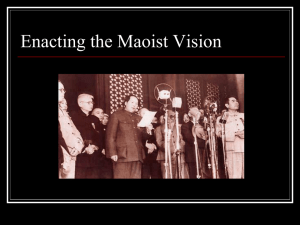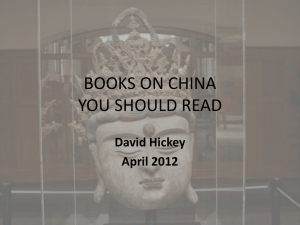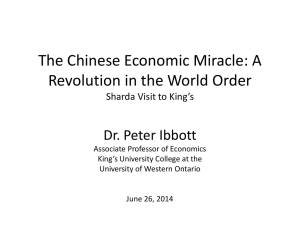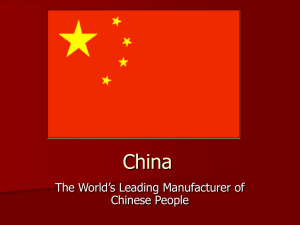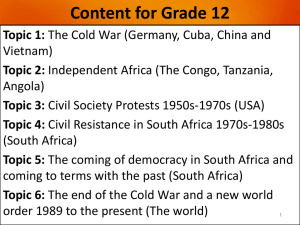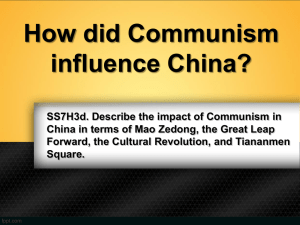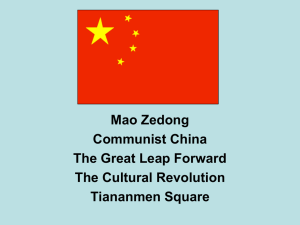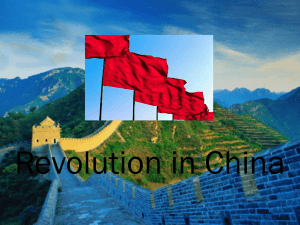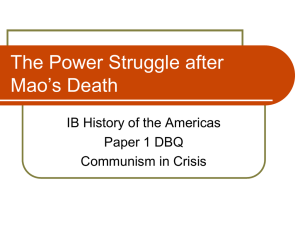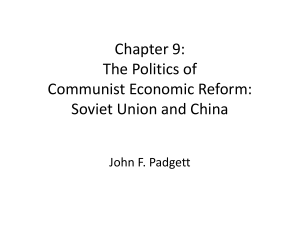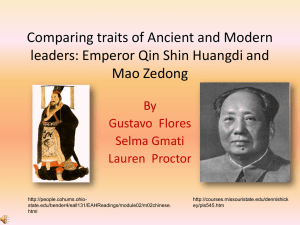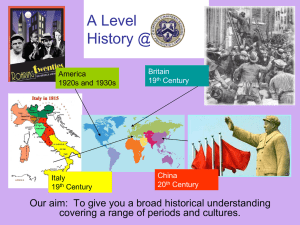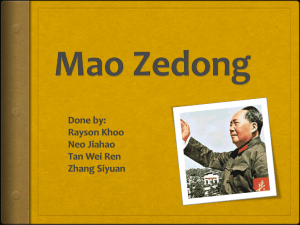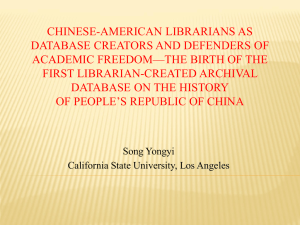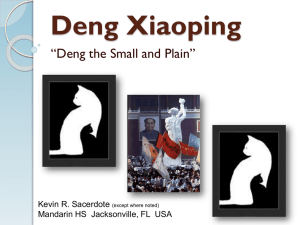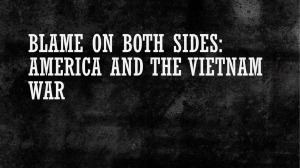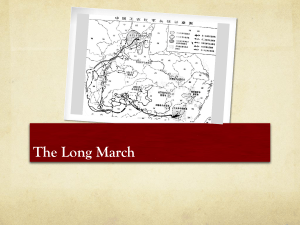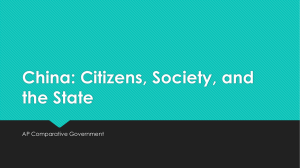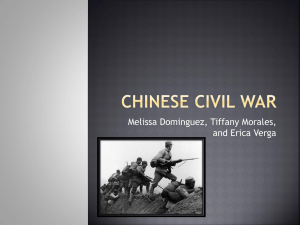Control by Imperialistic Nations
advertisement
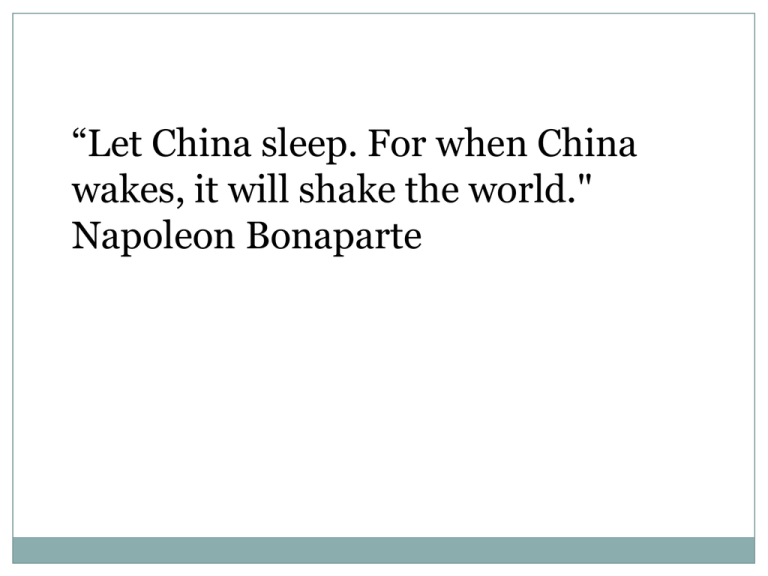
“Let China sleep. For when China wakes, it will shake the world." Napoleon Bonaparte Confucianism - The philosophy has shaped the Chinese political system since the 6th century B.C.E. It emphasized the importance of order and harmony, and encouraged Chinese citizens to submit to the emperor's power, and reinforced the emperors' responsibility to fulfill his duties conscientiously. This aspect of Confucianism may be tied to democratic centralism, or the communist belief in a small group of leaders who rule for the good of the people. The "Middle Kingdom" - Since ancient times, Chinese have referred to their country as zhongguo, meaning "Middle Kingdom", or the place that is the center of civilization. Foreigners were seen as "barbarians" whose civilizations are far inferior to China's, not just in terms of power, but also in ethics and quality of life. All countries are ethnocentric in their approaches to other countries, but China almost always assumed that no one else had much to offer them. After the empire's 19th century weakness was exploited by the imperialist powers, these traditional assumptions were challenged, but not destroyed. The 20th century brought the new influence of Maoism that emphasized the "right thinking" and moralism of Confucianism, but contradicted the hierarchical nature of the old regime with its insistence on egalitarianism. The late 20th century brought Deng Xiaopeng Theory, a practical mix of authoritarian political control and economic privatization. Maoism was idealistic and egalitarian, and even though it endorsed centralized power exercised through the top leaders of the party, it stressed the importance of staying connected to the peasants through a process called mass line. Mass line required leaders to listen to and communicate with ordinary folks, and without it, the legitimacy of the rulers was questionable. Maoism - Mao Zedong was strongly influenced by Karl Marx and Vladimir Lenin, but his version of communism is distinctly suited for China. Lenin emphasized the importance of a party vanguard to lead the people to revolution and beyond, Mao resisted the inequality implied by Lenin's beliefs. He believed in the strength of the peasant, and centered his philosophy around these central values: collectivism - valuing the good of the community above that of the individual. This belief suited the peasant-based communities that have existed throughout Chinese history, but scholars (valued by the old culture) have often been drawn to individualism. • struggle and activism - Mao encouraged the people to actively pursue the values of socialism, something he understood would require struggle and devotion. • mass line - Mao conceptualized a line of communication between party leaders, members, and peasants that would allow all to struggle toward realization of the goals of a communist state. The mass line involved teaching and listening on everyone's part. Leaders would communicate their will and direction to the people, but the people in turn would communicate through the mass line their wisdoms to the leaders. egalitarianism - Hierarchy was the key organizing principle in Chinese society before 1949, and Mao's emphasis on creating an egalitarian society was in complete opposition to it. • self-reliance - Instead of relying on the elite to give directions, people under Maoist rule were encouraged to rely on their own talents to contribute to their communities. Deng Xiaoping Theory - "It doesn't matter whether a cat is white or black, as long as it catches mice." This famous 1962 statement by Deng reflects his practical approach to solving China's problems. The result of his leadership was a dramatic turnaround of the Chinese economy through a combination of socialist planning and the capitalist free market. His political and social views, however, remained true to Communist tradition - the party should supervise all, and no allowances should be made for individual freedoms and/or democracy. CHANGE BEFORE 1949: China's oldest cultural and political traditions have long provided stability and longevity for the empire/country. These traditions come form the dynastic rule that lasted for many centuries. However, in recent years two disruptive influences - control by imperialistic nations (19th century) and revolutionary upheavals (20th century) have threatened that stability and provide challenges to modern China. Control by Imperialistic Nations - During the 19th century, the weakened Qing Dynasty fell prey to imperialistic nations - such as England, Germany, France, and Japan - who carved China into "spheres of influence" for their own economic gain. This era left many Chinese resentful of the "foreign devils" that they eventually rebelled against. Revolutionary upheavals - Major revolutions occurred in China in 1911 and 1949, with many chaotic times in between. Three themes dominated this revolutionary era. Socioeconomic Development - A major challenge of the 20th century has been the reestablishment of a strong economic and social fabric after the years of imperialistic control. During the 1920s, the newly formed Soviet Union served as a model for policymaking, but the Nationalists broke with them in 1928. Chiang Kai-shek became the President of China, and Mao Zedong and his communists were left an outlaw party. The Legend of the Long March - Strength for Mao's Communist Party was gained by the Long March - the 1934-36 pursuit of Mao's army across China by Chiang and his supporters. Chiang was trying to depose his rival, but his attempt to find and conquer Mao had the opposite effect. Mao eluded him until finally Chiang had to turn his attentions to the invading Japanese. Mao emerged as a hero of the people, and many of his loyal friends on the March lived on to be prominent leaders of the People's Republic of China after its founding in 1949. The People's Republic of China was born from a civil war between the Nationalists under Chiang Kai-shek and the Communists under Mao Zedong. After many years of competitive struggle, Mao's army forced Chiang Kai-shek and his supporters off the mainland to the island of Taiwan (Formosa). Mao named his new China the "People's Republic of China," and Chiang claimed that his headquarters in Taiwan formed the true government. The "Two Chinas", then, were created, and the PRC was not to be recognized as a nation by the United Nations until 1972 The early political development of the PRC proceeded in two phases: 1) The Soviet Model (1949-1957) - The Soviet Union had been supporting Mao's efforts since the 1920s, and with his victory in 1949, they began pouring money and expertise into the PRC. With the help, Chairman Mao and the Chinese Communist Party (CCP) quickly turned their attention to some of the country's most glaring social problems. A. Land Reform - This campaign redistributed property from the rich to the poor and increased productivity in the countryside. B. Civil Reform - They set about to free people from opium addiction, and they greatly enhanced women's legal rights. For example, they allowed women to free themselves from unhappy arranged marriages. These measures helped to legitimize Mao's government in the eyes of the people. 2) The Great Leap Forward (1958-1966) - Mao changed directions in 1958, partly in an effort to free China from Soviet domination -the spirit of nationalism is a force behind Mao's policy here - and partly because he was still unhappy with the degree of inequality in Chinese society. The Great Leap Forward was a utopian effort to transform China into a radical egalitarian society. It's emphasis was mainly economic, and it was based on four principles: 1. All-around development - Not just heavy industry (as under Stalin in the USSR), but almost equal emphasis to agriculture. 2. Mass mobilization - An effort to turn the sheer numbers of the population into an asset - better motivation, harder, work, less unemployment. 3. Political unanimity and zeal - An emphasis on party workers running government, not bureaucrats. Cadres - party workers at the lowest levels - were expected to demonstrate their party devotion by spurring the people on to work as hard as they could. 4. Decentralization - encouraged more government on the local level, less central control. The people can do it! THE CULTURAL REVOLUTION: 1966 – 1976 The Cultural Revolution encompassed political and social change, as well as economic. His main goal was the purify the party and the country through radical transformation. Important principles were • the ethic of struggle • mass line • collectivism • egalitarianism • unstinting service to society A primary goal of the Cultural Revolution was to remove all vestiges of the old China and its hierarchical bureaucracy and emphasis on inequality. Scholars were sent into the fields to work, universities and libraries were destroyed. Emphasis was put on elementary education - all people should be able to read and write - but any education that created inequality was targeted for destruction. The Gang of Four members consisted of Mao Zedong's last wife Jiang Qing, the leading figure of the group, and her close associates Zhang Chunqiao, Yao Wenyuan, and Wang Hongwen. The Gang of Four controlled the power organs of the Communist Party of China through the latter stages of the Cultural Revolution. It is unclear which major decisions were made through Mao Zedong and carried out by the Gang, and which were the result of the Gang of Four's own planning. Mao died in 1976, leaving his followers divided into factions: • Radicals - led by Mao's wife, Jiang Qing, one of the "Gang of Four," who supported the radical goals of the Cultural Revolution. • The Military - Always a powerful group because of the longlasting 20th century struggles that required an army, the military was led by Lin Biao, who died in a mysterious airplane crash in 1971. • The Moderates - led by Zhou Enlai, who emphasized economic modernization and limited contact with other countries, including the United States. Zhou influenced Mao to invite President Richard Nixon to China in 1972. He died only a few months after Mao. XIAOPINGS’s MODERNZATION: 1978 - 1997 The Gang of Four was arrested by the new CCP leader, Hua Guofeng, whose actions helped the Moderates take control. Zhou's death opened the path for new leadership from the Moderate Faction. By 1978, the new leader emerged - Deng Xiaping His vision drastically altered China's direction through "Four Modernizations" invented by Zhou Enlai before his death industry, agriculture, science, and the military. These modernizations have been at the heart of the country's official policy ever since. Under Deng's leadership, these policies have helped to implement the new direction: "Open door" trade policy - Trade with everyone, including capitalist nations like the U.S., that will boost China's economy. • Reforms in education - higher academic standards, expansion of higher education and research (a reversal of the policy during the Cultural Revolution) • Institutionalization of the Revolution restoring the legal system and bureaucracy of the Old China, decentralizing the government, modifying elections, and infusing capitalism. The Chinese Communist Party (CCP) is organized hierarchically by levels - village/township, county, province, and national. At the top of the system is the supreme leader, who until 1976 was Chairman Mao Zedong. The title "chairman" was abandoned after Mao's death, and the head of the party is now called the "general secretary." The party has a separate constitution from the government's constitution of 1982, and its central bodies are: National Party Congress - This body consists of more than 2000 delegates chosen primarily from congresses on lower levels. It only meets every five years, so it is obviously not important in policymaking. It usually rubberstamps decisions made by the party leaders, although in recent years it has acted somewhat more independently. Its main importance remains in its power to elect members of the Central Committee. Central Committee - The Committee has about 340 members (some of them are alternates) that meet together annually for about a week. They carry on the business of the National Party Congress between sessions, although their size and infrequent meetings limit their policy making powers. Their meetings are called plenums, and they are important in that they are gatherings of the political elites, and from their midst are chosen the Politburo and the Standing Committee. Politburo/Standing Committee - These most powerful political organizations are at the very top of the CCP structure. They are chosen by the Central Committee, and their decisions dictate government policies. The Politburo has 24 members and the Standing Committee - chosen from the Politburo membership - has only 7. They meet in secret, and their membership reflects the balance of power among factions and the relative influence of different groups in policy making. Government authority is formally vested in a system of people's congresses, which begins with a People's National Congress at the top and continues in hierarchical levels down through the provincial, city, and local congresses. Theoretically they are the people's legislatures, but in reality they are subject to party authority. The National People's Congress choose the President and Vice President of China, but there is only one party-sponsored candidate for each position. The President and Vice President serve five year terms, are limited to two terms, and must be at least 45 years old. The positions are largely ceremonial, though senior party leaders have always held them. Currently, Hu Jintao is both the president and the general secretary of the CCP. The Premier is the head of government, formally appointed by the president, but again, the position is always held by a member of the Standing Committee. He directs the State Council, which is composed of ministers who direct the many ministries and commissions of the bureaucracy. These are controlled by the principle of dual role - supervision from higher bodies in the government and by comparable bodies in the CCP. The bureaucracy exists on all levels - national, provincial, county, and local. These lower level positions are held by cadres, people in positions of authority who are paid by the government or party. Many are both government officials and party members, but not all. In all, about 30 million cadres around China see that the leaders' policies are carried out everywhere. China has a 4-tiered "people's court" system, organized hierarchically just as the people's Congresses are. A nationwide organization called the "people's procuratorate" provides public prosecutors and defenders to the courts. The criminal justice system works swiftly and harshly, with a conviction rate of more than 99% of all cases that come to trial. Prison terms are long and subject to only cursory appeal. 1000s of people have been executed during periods of government-sponsored anticrimes campaigns. Human Rights organizations criticize China for its extensive use of the death penalty. PEOPLE’S LIBERATION ARMY: PLA "Political power grows out of the barrel of a gun." The People's Liberation Army encompasses all of the country's ground, air, and naval armed services. In proportion to its population, the Chinese military presence is smaller than that of the United States. China has about 2.4 military personnel for every 1000 people, whereas the U.S. has 6.1. Military spending is only about 4 percent of that of the U.S., although some analysts suspect that the government deliberately underestimates the military budget. The military has never held formal political power in the People's Republic of China, but it has been an important influence on politics and policy. All of the early political leaders were also military leaders. For example, Mao and the other members of the "Old Guard", led the Long March of the 1930s primarily by military moves. The second half of Mao's famous quote is less often quoted: "Our principle is that the party commands the gun, and the gun must never be allowed to command the party." Clearly, the military has never threatened to dominate the party. It is represented in the government by the Central Military Commission, which has been led by many prominent party leaders, including Deng Xiaoping. The Tiananmen crisis in 1989 greatly harmed the image of the PLA, since the military was ordered to recapture the square and do so with brutal force. But the PLA continues to play an important role in Chinese politics. In 2002 two of the 24 members of the Politburo were military officers, and PLA representatives make up over 20 percent of the Central Committee membership. In 2003, Jiang Zemin's retention of his position as head of the Central Military Commission, despite his stepping down as president, indicates that he still has significant policymaking power. In the early days of the PRC virtually all peasants were organized into collective farms of approximately 250 families each. During the Great Leap Forward, farms were merged into gigantic people's communes with several thousand families. These communes were one of the weakest links in Mao's China, with production and rural living standards showing little improvement between 1957 and 1977. Communes were poorly managed, and peasants often didn't see the need to work hard, contrary to Mao's hopes of developing devotion through the mass line. In the early 1980s, Deng dismantled the communes and replaced them with a household responsibility system, which is still in effect today. In this system individual families take full charge of the production and marketing of crops. After paying government taxes and contract fees to the villages, families may consume or sell what they produce. In 1988 the National People's Congress officially created a new category of "private business" under the control of the party. It included urban co-ops, service organizations, and rural industries that largely operate as capitalist enterprises. Private businesses have grown by leaps and bounds since that time, and are far more profitable and dynamic than are the state-owned ones. The fastest growing sector of the Chinese economy is rooted in township and village enterprises (TVEs), rural factories and businesses that vary greatly in size, and are run by local government and private entrepreneurs. Although they are called collective enterprises, they make their own decisions and are responsible for their profits and losses. The growth of the TVE system has slowed the migration of peasants to the cities, and has become the backbone of economic strength in the countryside. FOREIGN POLICY UNDER MAO Until Mao's death in 1976, the PRC based its foreign policy on providing support for third world revolutionary movements. It provided substantial development assistance to a handful of the most radical states. (Korea and Vietnam). Under Mao, China's relationship with the USSR changed dramatically in the late 1950s from one of dependence to independence. During the 1920s and 1950s, the USSR gave large amounts of money, as well as technical and political advice to China. The countries broke into rivalry during the late 1950s when Mao decided that the Soviets had turned their backs on Marx and revolution. The Great Leap Forward and the Cultural Revolution affirmed China's independent path from Moscow's control. US/CHINESE RELATIONS The chill in China/USSR relationships encourage the U.S. to eye the advantages of opening positive interactions with China. As long as Mao was in control, his anti-capitalist attitudes – as well as U.S. containment policy - meant that the countries had no contacts until the early 1970s. Then, with Mao sick and weak, reformist Zhou Enlai opened the door to western contact. President Nixon and Secretary of State Henry Kissinger engineered negotiations, and Nixon's famous 1972 visit to China signaled a new era. Relations opened with a ping pong match between the two countries, but after Deng Xiaoping's leadership began in 1978, his open door policy helped lead the way to more substantial contact. Four Special Economic Zones (SEZs) were established in 1979. In these regions, foreign investors were given preferential tax rates and other incentives. Five years later fourteen more areas became SEZs, and today foreign investments and free market mechanisms have spread to most of the rest of urban China. Deng Xiaoping emphasized economic reform, but he continued to believe that the Party should be firmly in command of the country. In general, he did not support political reforms that included democracy and/or more civil liberties for citizens. Freedoms and incentives were granted to entrepreneurs, but they have operated largely under the patron-client system (guangxi). Despite the continuing tensions between economic and political policy, some democratic reforms can be seen in these ways: • Some input from the National People's Congress is accepted by the Politburo • More emphasis is placed on laws and legal procedures • Village elections are now semi-competitive, with choices of candidates and some freedom from the party's control
